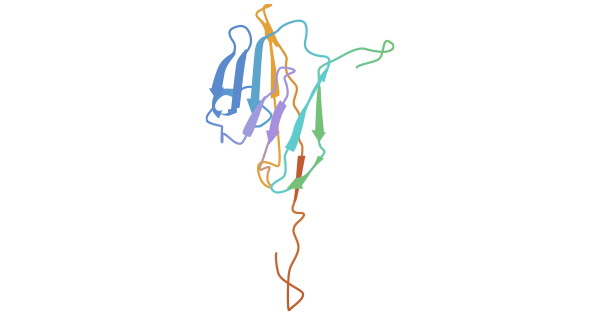CEACAM8:免疫球蛋白超家族的“低调”成员,生殖肿瘤、消化肿瘤研究的潜力候选靶点!
日期:2024-03-08 13:16:14
2024年2月,爱思维尔(Elsevier)数据库收录了一篇关于CEACAM8的生信文章,该研究通过分析多发性硬化症患者孕期的转录组数据,基于生物信息学分析工具GEO、STRING、KEGG等,发现了42个差异表达基因,其中包括CEACAM8,以及多个重要通路如IL-10、ErbB2和IL-17。这些结果表明CEACAM8可能是免疫炎症性疾病一个重要的靶点研究方向 [1]。早在2010年,已有1款靶向CEACAM8的药物用于骨髓炎。尽管,近年的研究鲜有关于CEACAM8临床的报道,但CEACAM8作为CEA家族的“低调”一员,陆续的研究表明其有望作为众多肿瘤的候选靶点,尤其是生殖和消化肿瘤研究。因此,针对CEACAM8进一步的研究探索可能为更多的研究方向带来参考!
1. 什么是CEACAM8?
1.1 CEACAM8的结构
癌胚抗原相关细胞粘附分子8(CEACAM 8)是免疫球蛋白超家族的CEA家族中的一个成员,属于GPI锚定的高度糖基化蛋白质,又被称为CD66b、NCA-95或CD67。CEACAM 8具有11个N-糖基化位点,其分子量为95kDa。一些研究提出了一种纯化CEACAM8的方法,可用于进一步研究其结构和功能,并在蛋白质水平证实了CEACAM8是CGM6(NCA-W272)基因的产物。此外,研究表明,CEACAM8可能调节CEACAM6的顺式和反式相互作用,并可能与其它CEACAMs中的一种或两种结合起调节作用。例如,表达CEACAM6和CEACAM8的粒细胞将主要形成顺式CEACAM6/8异二聚体,从而抑制CEACAM6的反式交联。然而,CEACAM8的结构目前仍需要进一步阐明(图1)[2-4]。
1.2 CEACAM 8的表达和功能
CEACAM8是一种粒细胞谱系细胞特异性的活化抗原,主要在人类嗜中性粒细胞和嗜酸性粒细胞中表达。在静息状态的中性粒细胞中,CEACAM8主要分布在质膜中的较少部分;然而,一旦激活,CEACAM8在质膜上的表达会通过细胞内的池子快速上调。CEACAM8作为癌胚抗原家族的一员,不仅参与调节细胞间的黏附,还在细胞信号传导中发挥重要作用,例如,调节与病原体结合、炎症、正常细胞的生长或分化有关的免疫反应、促进或抑制肿瘤生长、血管生成等等 [6-8]。

图1. CEACAM8的结构 [5]
2. CEACAM8相关的信号机制
2.1 CEACAM8在肿瘤中的调节机制
CEACAM8主要参与调节中性粒细胞的粘附和激活。中性粒细胞被认为是急性炎症反应中最早被募集的效应细胞之一,招募到肿瘤环境的中性粒细胞具有少量颗粒和活性氧ROS,其功能是复杂的。中性粒细胞不同活化状态具有相应的作用。肿瘤细胞能够产生出TGF-β,其能促进肿瘤相关中粒细胞的极化,这种类型的中粒细胞有促进癌症进展的可能,因为它能产生抑制细胞毒性淋巴细胞的生长因子,如血管内皮生长因子VEGF、基质金属蛋白酶9(MMP9)、肝细胞生长因子(HGF)等。因此,CEACAM8在中性粒细胞中的表达提示了它对肿瘤的发生和发展起着调节作用 [9-11]。
2.2 CEACAM8的其它免疫信号机制
此外,一些研究发现,CEACAM8在免疫调节中扮演了更广泛的角色,不仅局限于肿瘤。例如,在调节下呼吸道细菌感染方面,可溶性重组CEACAM8-Fc能够有效抑制表达CEACAM1的人肺上皮细胞对TLR2的免疫反应 [12]。此外,CEACAM8的过度表达与吞噬功能障碍密切相关,其中CEACAM8与CD11b比率的改变以及C5a受体C5aR1和C5L2的减少是关键因素。实验还表明,中性粒细胞麻痹程度与CEACAM8受体的表达水平直接相关,这可能为开发新的标志物提供了线索。总体而言,这些发现揭示了CEACAM8在调节免疫反应中的重要性 [13-15]。
3. CEACAM8和疾病研究
3.1 CEACAM8和乳腺癌研究
CEACAM8/CD66b被广泛认可作为肿瘤相关中性粒细胞(tumor associated neutrophils,TANs)的标志物,可用于监测肿瘤实质中TANs的数量。研究表明,在浸润性乳腺癌中,CEACAM8/CD66b的表达在扩散组中显著高于非扩散组,并且侵袭性亚组的生存率更低。CD66b阳性TANs与淋巴结转移、远处转移密切相关。进一步的研究结果显示CD66b+TANs会影响免疫细胞上PD-L1的表达,二者呈正相关的关系。总之,乳腺癌中存在TANs,且与肿瘤的转移、复发密切相关,检测CD66b阳性TANs的密度可能成为预测乳腺癌转移和复发的潜在指标 [16-17]。
3.2 CEACAM8和宫颈癌研究
宫预癌组织中,中粒细胞的浸润与患者无复发生存(RFS)密切相关,并且中粒细胞浸润数量的增加是宫颈癌患者复发的一个独立危险因素。如前所述,CEACAM8/CD66b是中粒细胞表明的特异性分子标志。一项研究表明,在宫颈癌患者的肿瘤和邻近基质组织中,CEACAM8含量较高,特别是在肿瘤周围观察到了高密度的CEACAM8。此外,在宫颈癌中,CD66b与CD8比率(Neutrophil to Lymphocyte Ratio,NLR)升高已被确定为不良的预后因素。进一步研究发现,CEACAM8与宫颈癌患者的无复发生存率相关,可以作为宫颈癌患者预后不良的潜在预测因子 [18-19]。
3.3 CEACAM8和膀胱癌研究
有关CEACAM8与膀胱癌之间的关系仅在少量最新的研究中发现,同样在膀胱癌中,NLR值的变化可以预测治疗效果和患者的生存期,高NLR比值,患者的癌症特异性死亡风险显著增高;此外,一项采用ELISA的方法检测尿液中CEACAM8的含量,测定的结果显示,在膀胱癌组CEACAM8含量高于非膀胱癌组尿液;不同病理分级的膀胱癌组尿液中CEACAM8浓度不同。研究结果提示,CEACAM8在膀胱癌的诊断、筛查及监测中具有较高的临床应用价值 [20-22]。
3.4 CEACAM8和非小细胞肺癌研究
在非小细胞肺癌(NSCLC)中,研究发现CEACAM8与疾病特异性生存密切相关,且存在着淋巴结转移,与预后不良有关。在肺鳞癌(SCC)中,CEACAM8密度升高预示着较好的生存率,而在肺腺癌(ADC)中,却预示着较差的生存率。对腺癌患者发现,CEACAM8水平与预后不良有关。但在组织间质中,CEACAM8与患者的预后无关。这表明CEACAM8可能对不同类型的非小细胞肺癌产生不同的影响,可能受到肿瘤分期和免疫活性的影响 [23-24]。
3.5 CEACAM8和消化系统肿瘤研究
CD66b阳性中性粒细胞是肿瘤相关中性粒细胞(tumor associated neutrophils,TANs)的标记,TANs在肿瘤微环境中对肿瘤的发生、发展起着至关重要的作用。目前,CEACAM8在多种消化系统肿瘤中,包括胃癌、肝癌、食管癌、口腔癌。例如,胃癌中,CEACAM8的浸润增加,与胃癌的预后密切相关。高CEACAM8浸润与肿瘤大小、分化程度和早期TNM分期显着相关 [25-26];TANs被发现通过GM-CSF-PD-L1途径抑制T细胞的增殖和功能,促进胃癌的进展 [27-28]。肝癌患者中,CEACAM8在肿瘤周围组织中的表达密度高于肿瘤内 [29];TANs可能通过分泌BMP2和TGF-β,增加其干细胞特性 [30]。此外,TANs通过IL-7a促进结肠癌细胞的侵袭和迁移 [31]。在食管鳞状细胞癌患者中,肿瘤内CEACAM8的增加与淋巴结转移和晚期病理分期密切相关 [32]。
4.CEACAM8的临床药物研究前景
CEACAM8作为肿瘤研究的潜在靶点,展现出了的临床药物研究前景。Tc 99m besilesomab是一种CEACAM8抑制剂,在骨髓炎的治疗中已获得批准上市,并有望在感染、皮肤和肌肉骨骼疾病等领域发挥作用,由CIS Bio International SA机构开发。现阶段国内外关于CEACAM8临床药物研究还比较少,仅1款靶向靶向CEACAM8药物上市。其它2款的药物,Yttrium-90 besilesomab和Besilesomab尚未有临床信息披露,但表明了该靶点领域的积极研究和开发态势,这为未来CEACAM8相关药物的临床应用提供了新的希望。
为鼎力协助各药企针对CEACAM8在生殖肿瘤、消化肿瘤等在临床中的研究,j9九游会登录入口首页CUSABIO推出CEACAM8(CSB-MP004954HU1)活性蛋白产品,助力您在对CEACAM机制方面的研究或其潜在临床价值的探索。
j9九游会登录入口首页CUSABIO蛋白CEACAM8

Purity was greater than 95% as determined by SDS-PAGE.

Immobilized Human CEACAM8 at 2μg/mL can bind Anti-CEACAM8 recombinant antibody (CSB-RA005168MA1HU). The EC50 is 19.38-21.68 ng/mL.
参考文献:
[1] Hernández-Preciado, Martha Rocio, et al. "Gene expression in multiple sclerosis during pregnancy based on integrated bioinformatics analysis." Multiple Sclerosis and Related Disorders 82 (2024): 105373.
[2] Zhao, Linshu, et al. "Purification and characterization of a 95-kDa protein-carcinoembryonic antigen-related cell adhesion molecule 8 -from normal human granulocytes." Journal of immunological methods 270.1 (2002): 27-35.
[3] Zhao, Linshu. CarcinoEmbryonic Antigen-related Cell Adhesion Molecule 8 (CEACAM8): Purification, Characterization, Cellular and Clinical Studies Diss. Acta Universitatis Upsaliensis, 2004.
[4] Zhao, Linshu, et al. "An enzyme-linked immunosorbent assay for human carcinoembryonic antigen-related cell adhesion molecule 8, a biological marker of granulocyte activities in vivo." Journal of immunological methods 293.1-2 (2004): 207-214.
[5] https://www.genecards.org/cgi-bin/carddisp.pl?gene=CEACAM8
[6] Kuroki, Motomu, et al. "Identification and comparison of residues critical for cell-adhesion activities of two neutrophil CD66 antigens, CEACAM6 and CEACAM8." Journal of Leukocyte Biology 70.4 (2001): 543-550.
[7] Oikawa, Shinzo, et al. "Extracellular N-domain alone can mediate specific heterophilic adhesion between members of the carcinoembryonic antigen family, CEACAM6 and CEACAM8." Biochemical and Biophysical Research Communications 278.3 (2000): 564-568.
[8] Ribon, Matthieu, et al. "Extracellular chromatin triggers release of soluble CEACAM8 upon activation of neutrophils." Frontiers in Immunology 10 ( 2019): 1346.
[9] Ambrosi, Cecilia, et al. "Acinetobacter baumannii targets human carcinoembryonic antigen-related cell adhesion molecules (CEACAMs) for invasion of pneumocytes." Msystems 5.6 (2020): 10-1128.
[10] Klaile, Esther, et al. "Antibody ligation of CEACAM1, CEACAM3, and CEACAM6, differentially enhance the cytokine release of human neutrophils in responses to Candida albicans." Cellular Immunology 371 (2022): 104459.
[11] Beauchemin, Nicole, and Azadeh Arabzadeh. "Carcinoembryonic antigen-related cell adhesion molecules (CEACAMs) in cancer progression and metastasis." Cancer and Metastasis Reviews 32 (2013): 643-671.
[12] Singer, Bernhard B., et al. "Soluble CEACAM8 interacts with CEACAM1 inhibiting TLR2-triggered immune responses." PloS one 9.4 (2014): e94106.
[13] Groeneveld, Kathelijne M., et al. "Penetrating thorax injury leads to mild systemic activation of neutrophils without inflammatory complications." Injury 45.3 (2014): 522-527.
[14] Frank, Eugenia. Charakterisierung des myeloiden Compartments in Patienten* innen mit ANCA-assoziierten Erkrankungen mittels CyTOF. Diss. 2022.
[15] Pańczyszyn, Anna, and Maciej Wieczorek. "Role of CEACAM in neutrophil activation." Advances in Hygiene and Experimental Medicine 66 (2012): 574-582.
[16] Iwabuchi, Erina, Yasuhiro Miki, and Hironobu Sasano. "The visualization of protein-protein interactions in breast cancer: deployment study in pathological examination." Acta Histochemica et Cytochemica 54.6 (2021): 177-183.
[17] Tokumaru, Yoshihisa, et al. "Prognostic significance of intratumoral neutrophil lymphocyte ratio (NLR) in breast cancer patients." Cancer Research 81.13_Supplement (2021): 2697-2697.
[18] Imamura, Ayaka, et al. "Comparative analysis of the antitumor immune profiles of paired radiotherapy-naive and radiotherapy-treated cervical cancer tissues." Anticancer Research 42.7 (2022): 3341-3348.
[19] AN, Long-fei, et al. "The character of cervical cancer patients and healthy women in experiment group and validation group." China Biotechnology 36.9 ( 2016): 1-10.
[20] Cho, Yang Hyun, Seung Il Jung, and Eu Chang Hwang. "Novel and emerging surveillance markers for bladder cancer. "Bladder Cancer. Academic Press, 2018. 599-612.
[21] Kammerer, Robert, et al. "The tumour suppressor gene CEACAM1 is completely but reversibly downregulated in renal cell carcinoma." The Journal of Pathology: A Journal of the Pathological Society of Great Britain and Ireland 204.3 (2004): 258-267.
[22] Haga, Kazunori, et al. "968: Gelsolin Gene Silencing Involving Unusual Chromatin Structures and a Novel Stem Loop Structure of the Promoter Region in Human Bladder Cancer." The Journal of Urology 171.4S (2004): 256-257.[23] Kim, Eun Young, et al. "Overexpression of CEACAM6 activates Src-FAK signaling and inhibits anoikis, through homophilic interactions in lung adenocarcinomas." Translational oncology 20 (2022): 101402.
[24] Nakamura, Haruhiko, et al. "Differential prognostic values of mRNA expression of CEACAM gene family members in nonsmall cell lung cancer." Current Biomarker Findings (2016): 23-30.
[25] Xia, Ran, et al. "Pathogenic interactions between Helicobacter pylori adhesion protein HopQ and human cell surface adhesion molecules CEACAMs in gastric epithelial cells." Iranian journal of basic medical sciences 22.7 (2019): 710.
[26] Liu, Jia-Ning, et al. "CEACAM5 has different expression patterns in gastric non-neoplastic and neoplastic lesions and cytoplasmic staining is a marker for evaluation of tumor progression in gastric adenocarcinoma." Pathology-Research and Practice 210.10 (2014): 686-693.
[27] Tang, Di, et al. "Tumor-infiltrating PD-L1+ neutrophils induced by GM-CSF suppress T cell function in laryngeal squamous cell carcinoma and predict unfavorable prognosis." Journal of Inflammation Research (2022): 1079-1097.
[28] Wang, Ting-ting, et al. "Tumor-activated neutrophils in gastric cancer foster immune suppression and disease progression through GM-CSF-PD-L1 pathway." Gut 66.11 (2017): 1900-1911.
[29] Zhang, Zhen, et al. "Identification of circadian clock genes as regulators of immune infiltration in Hepatocellular Carcinoma." Journal of Cancer 13.11 (2022): 3199.
[30] Rezaei, Tayebeh, et al. "microRNA-181 serves as a dual-role regulator in the development of human cancers." Free Radical Biology and Medicine 152 (2020). : 432-454.
[31] Long, Xiaohang, et al. "Peptostreptococcus anaerobius promotes colorectal carcinogenesis and modulates tumour immunity." nature microbiology 4.12 (2019): 2319-2330.
[32] Guo, Caiyu, et al. "Establish immune-related gene prognostic index for esophageal cancer." Frontiers in Genetics 13 (2022): 956915.











